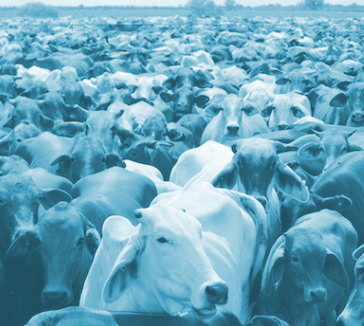Livestock's contribution increased
 New research suggests livestock have been directly responsible for about 23 per cent of annual global warming.
New research suggests livestock have been directly responsible for about 23 per cent of annual global warming.
Climate scientists say the direct contribution of livestock to global warming is significantly greater than estimates based on CO2-equivalent emissions would suggest.
A new study titled ‘How much do direct livestock emissions actually contribute to global warming?’, shows that livestock were directly responsible for about 23 percent of the total warming in 2010, and further demonstrates that methane plays a critical role in global warming.
There is a lot of debate about how best to compare emissions of different greenhouse gases, and it appears previously models may have underestimated the role of livestock.
“Some people argue that comparing emissions using the so-called Global Warming Potential is wrong and that efforts to reduce methane are misplaced because it is a short-lived greenhouse gas,” says Dr Andy Reisinger from the New Zealand Agricultural Greenhouse Gas Research Centre (NZAGRC).
“So we used a simple climate model to understand how much the emissions directly attributable to livestock contribute to actual warming, without the use of any simplifying emission metrics.”
“We found that of the warming the world had experienced by 2010, as much as 19 percent was due to direct historical methane and nitrous oxide emissions from livestock. Once you add the warming due to emissions when land is converted into pastures, you end up with a total contribution of 23 percent to current warming. This estimate does not consider indirect emissions from energy use or growing livestock feed such as soy beans, so this can be taken as a lower bound of the actual contribution of livestock to current warming.”
Dr Reisinger says the study also looked at how much livestock will contribute to future warming under different scenarios.
“If emissions from all sectors were to increase unabated, the world would warm by more than 4°C but livestock would make a declining contribution to this. In other words, if the world goes to hell in a handbasket, it won’t be because of livestock,” he said.
“But if the world makes efforts consistent with the Paris Agreement to rapidly reduce emissions from all sectors, including livestock, then livestock could still contribute almost one fifth of the warming in 2100. That’s a big part and shows that reducing livestock emissions can play an important role in helping achieve the goals of the Paris Agreement.”
It is important to find out how reductions in livestock emissions would impact on the allowable carbon dioxide emissions in long term temperature goals.
“We know that net global carbon dioxide emissions have to go to zero sometime after 2050 to limit warming to 1.5 or 2°C,” Dr Reisinger said.
“This fact doesn’t change regardless of what we do with livestock emissions. But if we could reduce livestock emissions beyond what is currently considered feasible, this would give us just a little more breathing space in that herculean effort to phase out carbon dioxide completely,” Dr Reisinger explains.
“This is particularly pressing if we want to limit warming to 1.5°C, a goal sought by many Pacific Island countries concerned about sea level rise. If we could halve livestock emissions by the year 2100, it could increase the carbon budget (the finite amount of CO2 that can still be emitted to keep warming under 1.5°C as per the Paris agreement) by as much as a third—that’s massive.”
The new findings help answer any lingering questions over the role of livestock emissions in climate change.
“The unambiguous answer is yes, it’s essential to reduce livestock emissions in order to reduce climate change consistent with what countries signed up to under the Paris Agreement,” Dr Reisinger says.
“If we’re serious on a global level about limiting warming to 1.5 or 2°C then reducing livestock emissions has to be a part of the effort, otherwise the task becomes even more difficult than it already is.”








 Print
Print